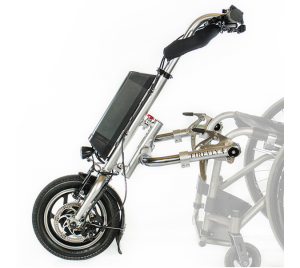
Group Description
Looking to travel to Japan and need accessibility information? Join our group discussion on accessible travel in Japan and discover the best tips and tricks.
The Japan group is a community of travelers who are passionate about exploring Japan and sharing their experiences with others. This group is dedicated to discussing all aspects of accessible travel in Japan, including accommodations, transportation, tourist attractions, and cultural experiences, as well as links to accessible travel companies and organizations.
Whether you have been here a million times or planning your first visit, the Japan group is a welcoming community that offers support and encouragement for travelers of all abilities. By sharing their experiences and knowledge, members of the group are helping to make travel in Japan more accessible and enjoyable for everyone.
Travel with Rio Mobility’s Firefly power attachment to manual chair
Travel with Rio Mobility’s Firefly power attachment to manual chair
Posted by giacopini on June 24, 2018 at 3:23 pmI read about problems with Mobility scooters in Japan. Would you expect any problems if travel with this?
 Accessible Japan replied 6 years, 8 months ago 3 Members · 11 Replies
Accessible Japan replied 6 years, 8 months ago 3 Members · 11 Replies- 11 Replies
Unfortunately, you are very likely to have problems on JR lines (subways are more forgiving). A lady who came two years ago with a similar device had issues with the shinkansen.
They have revised the law since them but only really dealing with “scooters” but there is a high likelihood that that may not be recognized as a “scooter” by the staff. (Japan is a land of rules and definitions, so if something doesn’t neatly fit in to the definition it more than likely becomes a “no”)
According to JR:
Handle-type electric wheelchairs that can be used
- Wheelchairs with the following approximate dimensions: height and length of 120 cm, width of 70 cm.
- In case of using a car with a deck, they’ll need to use the multipurpose room, so we should verify that the wheelchair is 180 degree turn and straight angle capable.
- It should be able to turn a straight angle in no more than 5 direction changes on a 90 cm wide path. Also, it should be able to do a straight turn on a 100 cm path with no direction changes.
- It should be able to do a 180 degree turn on a path of less than 180 cm width.
In case the conditions are not met
The facilities are designed based on the guidelines provided by the Ministry of Land, Infrastructure, Transport and Tourism and they have the above as requirements, as such, if the wheelchair doesn’t meet them, it cannot be used.
Reference: http://www.westjr.co.jp/global/en/support/accessibility/
Far from ideal.
We suggest you contact JR directly and tell them your scooter specifics. You can use the following inquiry form to ask for help directly:
https://entry.jr-odekake.net/webapp/form/18112_quab_1/index.doCan you remove the device? It may be easiest to remove it before using the train and then reattach it after getting off. You should have no problem on the streets, but stores and restaurants are very cramped, so turning will be hard…
Sorry it isn’t a positive answer, but hope this helps.
I assume this is what we are talking about?
Then, it will also be too long likely and the turn radius not sharp enough. I think you will have big issues at the shinkansen without removing.
If it were me, I would try to ride once to test the waters. If it seems OK, then maybe keep trying. But if it looks like every ride will be a fight, it might not be worth it and less energy to just remove it before entering the station.
Yes, it’s removable, so that’s what we intend to do. Thanks!
I’m sorry Japan is not more adaptable to new mobility devices, but I’m glad there is an easy solution.
Hopefully, seeing your Firefly will help open some eyes to the variety of mobility equipment in the world!
Will this be an issue on all of our train trips:
Kansei Airport to Kyoto Station?
Kyoto Station to Osaka (round trip)?
Kyoto Station to Tokyo?
Yokohama Pier to Narita?
And would we benefit from a Japan Rail Pass and if so which one?
(our 1st 3 train trips will be July 4-8 but the last one will be July 19.)
Starting with the JR rail pass, once you activate it the timer starts ticking. So, if you want to use it for all of them, you would need a 3 week pass. But since there is a huge gap between July 4-8 and July 19th, it might be cheaper to buy a week-long pass for the 4-8th, and just pay cash for the 19th.
As for the trips:
- Kansei Airport to Kyoto Station?
If on Haruka, very likely yes - Kyoto Station to Osaka (round trip)?
Possible, but maybe not if you use a regular commuter train - Kyoto Station to Tokyo?
Almost definitely - Yokohama Pier to Narita?
If you use regular commuter trains, might be ok.
If you want to use NEX, almost definitely…
Hope that helps
- Kansei Airport to Kyoto Station?
Not that this adds a lot to your conversation, but I have seen that type of mobility device once in Japan. A friend of a friend (Japanese) was scooting around and showing off with it last summer at a wheelchair tennis event in Nagoya. The only thing I remember him saying was that he liked the freedom of going long distances ‘above ground’, such as the several kilometers from his home to Nagoya Station, as opposed to taking the subway. I don’t recall any mention of using it on public transport, so sorry.
Oh! Would you be able to ask your friend about trains/subways? I have no personal experience, so hearing from someone who does have experience would be helpful!
Finally met up with the guy who uses a firefly type (battery-powered handle-driven) attachment to his wheelchair at this year’s tennis tournament. I asked him about taking it on the train and he said that he hadn’t tried it. He had heard of others that have used it on the trains, so it sounds like it might be possible.
Just as a footnote, there were 2 or 3 guys that were using that type of device at this year’s tournament (not to play tennis, but to move around the facility), up from one last year, so they might be catching on in Japan.
Log in to reply.
